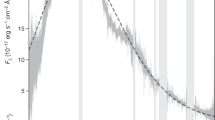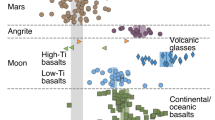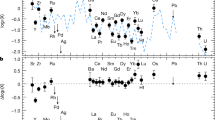Abstract
In a series of recent papers Runcorn and coworkers1–3 have hypothesised that the radioactive decay of siderophile super-heavy elements (SHE) provided the heat source which produced early melting of the Moon and which drove an ancient lunar core dynamo. If such elements had a half life of ∼108yr then this provides a natural explanation for the decay of the postulated lunar core dynamo and the associated magnetic field on a time scale of this order. It would be surprising if these SHE had accreted into the early Moon and not into the parent bodies of the iron meteorites. Libby et al.4 have suggested that the iron meteorites did accrete SHE, and have argued that SHE fission has produced the observed peaks in the trace element abudances in iron meteorites at charge number Z ∼ 40, 50 and 80. Libby et al.4 claim that these abundances are well above those which may be expected on the basis of a simple calculation of the solubilities in Fe of these elements. These peak trace element abundances are ∼10 p.p.m. by weight and assuming an element at the peak corresponds to a fission yield of 5% then the original abundance of SHE in the metal must have been in the region of 2 × 10−4 kg kg−1. Such high concentrations of fissioning elements should produce a number of observable effects, one of which is the production of very large numbers of radiation damage tracks in the borders of silicate grains along the boundary with metal regions. This boundary contribution falls to zero at a distance within the silicate crystal equal to one fission fragment range (∼5–10 µm). We report here a search for fissioning species in the metal phases of IA iron meteorites and a pallasite. No excesses of tracks in these boundary regions have been found and an upper limit of ∼10−12kg kg−1 can be placed on the concentration of fissioning superheavy elements in the metal of the Odessa IA iron at the time when fission track retention began.
This is a preview of subscription content, access via your institution
Access options
Subscribe to this journal
Receive 51 print issues and online access
$199.00 per year
only $3.90 per issue
Buy this article
- Purchase on Springer Link
- Instant access to full article PDF
Prices may be subject to local taxes which are calculated during checkout
Similar content being viewed by others
References
Runcorn, S. K. Science 199, 771–773 (1978).
Runcorn, S. K. Earth planet. Sci. Lett. 39, 193–198 (1978).
Runcorn, S. K., Libby, L. M. & Libby, W. F. Nature 270, 678–681 (1977).
Libby, L. M., Libby, W. F. & Runcorn, S. K. Nature 278, 613–617 (1979).
Krishnaswami, S., Lal, D., Prabhu, N. & Tamhane, A. S. Science 174, 287–291 (1971).
Fleischer, R. L., Price, P. B., Walker, R. M. & Maurette, M. J. geophys. Res. 72, 331–353 (1967).
Green, P. F., Bull, R. K. & Durrani, S. A. Geochim. cosmochim. Acta 42, 1359–1366 (1978).
Kirsten, T., Jordan, J., Richter, H., Pellas, P. & Storzer, D. Meteoritics 12, 279–281 (1977).
Audouze, J., Bibring, J. P., Dran, J. C., Maurette, M. & Walker, R. M. Astrophys. J. Lett. 206, L185–L189 (1976).
Wasserburg, G. J. & Burnett, D. S. in Meteorite Research (ed. Millman, P. M.) 467–479 (1969).
Author information
Authors and Affiliations
Rights and permissions
About this article
Cite this article
Bull, R. A search for superheavy-element fission-tracks in iron meteorites. Nature 282, 393–394 (1979). https://doi.org/10.1038/282393a0
Received:
Accepted:
Issue Date:
DOI: https://doi.org/10.1038/282393a0
This article is cited by
-
Helium, neon, and argon in the iron meteorites Dongling, Nantan and Ningbo
Chinese Journal of Geochemistry (1986)
-
Lunar magnetism, polar displacements and primeval satellites in the Earth–Moon system
Nature (1983)
-
A search for evidence of superheavy-element fission in chondritic metal
Nature (1982)
-
Superheavy-element fission tracks in iron meteorites
Nature (1980)
-
Superheavy-element fission tracks in iron meteorites (reply)
Nature (1980)
Comments
By submitting a comment you agree to abide by our Terms and Community Guidelines. If you find something abusive or that does not comply with our terms or guidelines please flag it as inappropriate.



